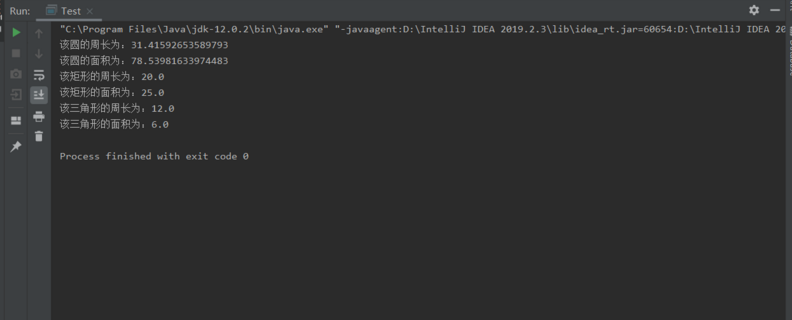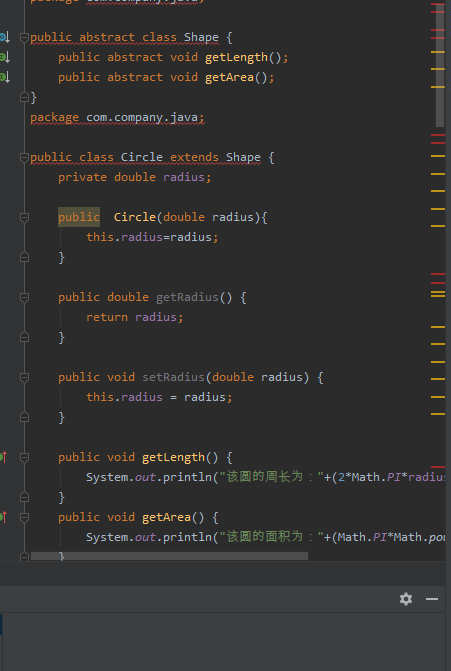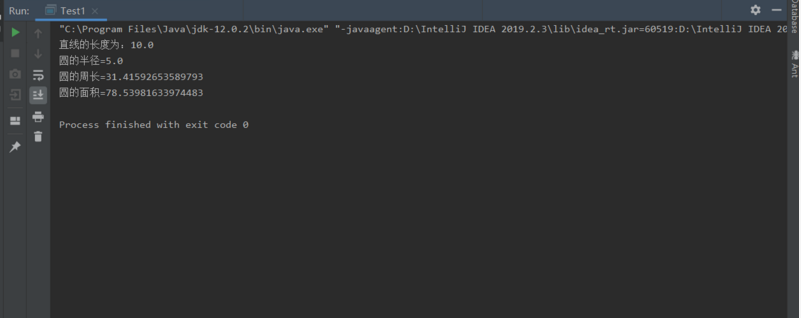实验四 类的继承
实验目的
理解抽象类与接口的使用;
了解包的作用,掌握包的设计方法
实验要求
掌握使用抽象类的方法。
掌握使用系统接口的技术和创建自定义接口的方法。
了解 Java 系统包的结构。
掌握创建自定义包的方法。
实验内容
(一)抽象类的使用
设计一个类层次,定义一个抽象类--形状,其中包括有求形状的面积的抽象方法。 继承该抽象类定义三角型、矩形、圆。 分别创建一个三角形、矩形、圆存对象,将各类图形的面积输出。 注:三角形面积s=sqrt(p*(p-a)*(p-b)*(p-c)) 其中,a,b,c为三条边,p=(a+b+c)/2
2.编程技巧
(1) 抽象类定义的方法在具体类要实现; (2) 使用抽象类的引用变量可引用子类的对象; (3) 通过父类引用子类对象,通过该引用访问对象方法时实际用的是子类的方法。可将所有对象存入到父类定义的数组中。
(二)使用接口技术
1定义接口Shape,其中包括一个方法size(),设计“直线”、“圆”、类实现Shape接口。分别创建一个“直线”、“圆”对象,将各类图形的大小输出。 编程技巧 (1) 接口中定义的方法在实现接口的具体类中要重写实现; (2) 利用接口类型的变量可引用实现该接口的类创建的对象。
(一)抽象类的使用
实验代码
package com.company.java; public abstract class Shape { public abstract void getLength(); public abstract void getArea(); } package com.company.java; public class Circle extends Shape { private double radius; public Circle(double radius){ this.radius=radius; } public double getRadius() { return radius; } public void setRadius(double radius) { this.radius = radius; } public void getLength() { System.out.println("该圆的周长为:"+(2*Math.PI*radius)); } public void getArea() { System.out.println("该圆的面积为:"+(Math.PI*Math.pow(radius,2))); } } package com.company.java; public class Rectangle extends Shape{ private double width; private double high; public Rectangle(double width,double high){ this.width=width; this.high=high; } public double getHigh() { return high; } public double getWidth() { return width; } public void setHigh(double high) { this.high = high; } public void setWidth(double width) { this.width = width; } public void getLength() { System.out.println("该矩形的周长为:"+2*(width+high)); } public void getArea() { System.out.println("该矩形的面积为:"+width*high); } } package com.company.java; public class Triangle extends Shape { private double a,b,c; double p; public Triangle(double a,double b,double c){ this.a=a; this.b=b; this.c=c; p=(a+b+c)/2; } public double getA() { return a; } public double getB() { return b; } public double getC() { return c; } public void setA(double a) { this.a = a; } public void setB(double b) { this.b = b; } public void setC(double c) { this.c = c; } public void getLength() { System.out.println("该三角形的周长为:"+(a+b+c)); } public void getArea() { System.out.println("该三角形的面积为:"+Math.sqrt(p*(p-a)*(p-b)*(p-c))); } } package com.company.java; public class Test { public static void main(String[] args){ Shape sha1=new Circle(5); Shape sha2=new Rectangle(5,5); Shape sha3=new Triangle(3,4,5); sha1.getLength(); sha1.getArea(); sha2.getLength(); sha2.getArea(); sha3.getLength(); sha3.getArea(); } }
实验结果


(二)使用接口技术
实验代码
package com.company; interface Shape { public abstract void size(); } package com.company; public class Test { public static void plugin(Shape sha){ sha.size(); } } package com.company; public class Wire implements Shape{ private double lenght; public Wire(double lenght){ this.lenght=lenght; } public double getLenght() { return lenght; } public void setLenght(double lenght) { this.lenght = lenght; } public void size() { System.out.println("直线的长度为:"+lenght); } } package com.company; public class Circle implements Shape { private double radius; public Circle(double radius){ this.radius=radius; } public void setRadius(double radius) { this.radius = radius; } public double getRadius() { return radius; } public void size() { System.out.println("圆的半径="+radius); System.out.println("圆的周长="+2*radius*Math.PI); System.out.println("圆的面积="+Math.PI*Math.pow(radius,2)); } } package com.company; public class Test1 { public static void main(String[] args){ Test.plugin(new Wire(10)); Test.plugin(new Circle(5)); } }
实验结果

总结
本周学习了本周学习了抽象类的基本概念、接口的基本概念,以及抽象类与接口实例化和实际应用。抽象类的多态性的上下接口还需要学习
需要注意的一小点 抽象方法必须定义成public访问权限。需要通过子类实现
| 区别点 | 抽象类 | 接口 |
|---|---|---|
| 定义 | 包含一个抽象方法的类 | 抽象方法和全局变量的集合 |
| 组成 | 构造方法,抽象方法,普通方法,常量,变量 | 常量,抽象方法 |
| 使用 | 子类继承抽象类 | 子类实现接口 |
| 关系 | 抽象类可以实现多个接口 | 接口不能继续抽象类,但允许继承多个接口 |
| 常见设计模式 | 模板设计 | 工厂设计,代理设计 |
| 对象 | 都通过对象的多态性产生实例化对象 | |
| 局限 | 抽象类有单继承的局限 | 接口没有此局限 |
| 实际 | 作为一个模板 | 是作为一个标准或是表示一种能力 |
| 选择 | 如果抽象类和接口都可以使用的话,优先使用接口,因为避免单继承的局限 |